Northland
After spending most of the winter in the beautiful area of the Bay of Plenty, where the temperatures were the most mild, we went back on the road again towards the extreme north of the northern island known as Northland.
We made a short itinerary with the key points of this region, but also our unexpected discoveries along the way.
Waipu
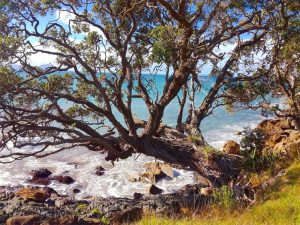
Small city that welcomed us under a sunny blue sky. Nothing really remarkable but a pleasant hike along a quite magnificent coastal path, as well as a visit to the glowworms caves. Let us note, Waipu cave is a magical place for who wants to take itself for a speleologist in fairy quest. After crossing by two times the subterranean river (sometimes inhabited by eels), you must reach the second largest cave in the darkness and extinguish all light sources to enjoy a sumptuous show.
It’s free, a bit dirty and slippery, but really mind blowing. A must-have for sure then arm yourself with good shoes and clothes and GO !
There is also a large white sandy beach in Waipu, where it is sometimes possible to surf, and a history museum.
Whangarei
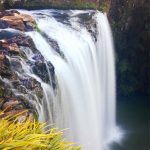 The northern capital it’s a big city where you can find everything you need. We only perceived some charms in spite of some pleasant shopping streets. However, the environment tends to be conserved there, so you can find a multitude of parks with many paths ranging from small walk to great hiking.
The northern capital it’s a big city where you can find everything you need. We only perceived some charms in spite of some pleasant shopping streets. However, the environment tends to be conserved there, so you can find a multitude of parks with many paths ranging from small walk to great hiking.
We discovered the “Whangarei falls” and took a loop along the river leading to the undergrowth towards the Kauris, ancient sacred trees.
Further down the bay, we also climbed Mount Manaia, which delivers a sublime view of the place. There is also the small 5 km walk on the seafront, borrowed by all the inhabitants at the end of the day, well arranged and very pleasant.
For adventure lovers, do not miss the visit of “Abbey Caves“, a walk leading you to the depths of the earth through 3 caves.
Go with good shoes, frontal light and resistant clothes because it takes a bit of dexterity to survey these slippery and steep places, with water sometimes up to the knees. Nothing insurmountable to discover these magnificent caves and the glowworms that inhabit there.
Finally, it is from here that the majority of reservations and departures are made for all the excursions and activities of the far north.
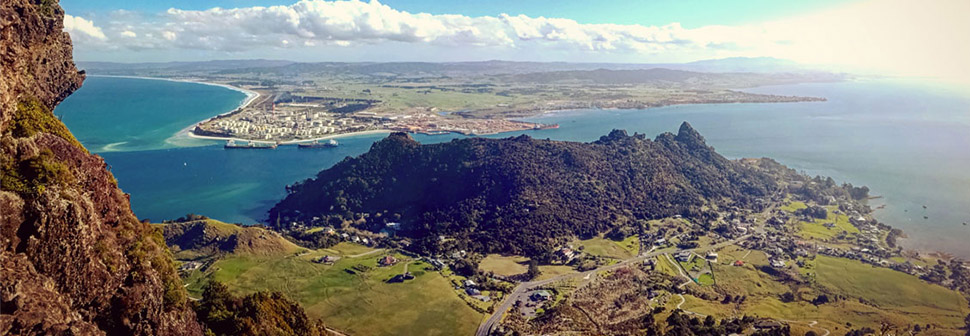
Matapouri & Tutukaka coast
Matapouri beach is famous for its clear water, white sand, lying trees, the heat of its water in summer, but also for its “mermaid pools“.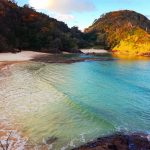 Natural pools phenomene, in practice there is only one big water hole where you can dip, the others are rather stormed by algae and, to be honest, that was not our favorite part. For us, Matapouri beach is pretty enought, besides, we did not resist to take a swim there, even in the middle of winter.
Natural pools phenomene, in practice there is only one big water hole where you can dip, the others are rather stormed by algae and, to be honest, that was not our favorite part. For us, Matapouri beach is pretty enought, besides, we did not resist to take a swim there, even in the middle of winter.
A little further on the road we arrive at Sandy Bay, from where we took the departure of the whananaki coastal hike, known for crossing the longest pedestrian bridge in the southern hemisphere. Count 4h return for this ride which has nothing spectacular, unfortunately the walk does not skirt virtually the coast. The bridge, although cute, has nothing really extraodinary. However, all the bays that make up the Tutukaka Coast are really beautiful. 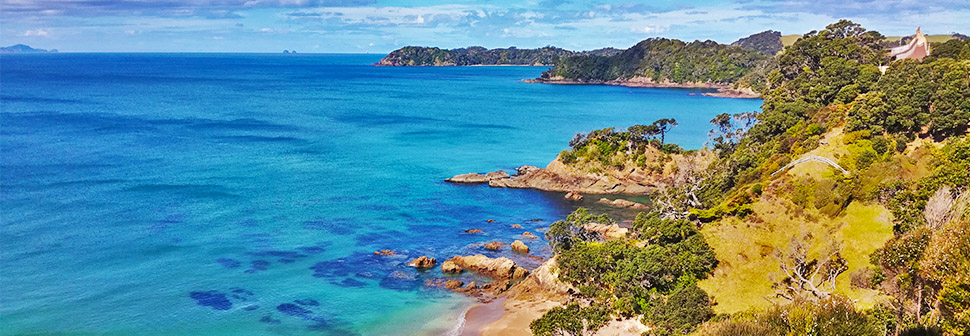
Russell, Paihia, Waitangi
Concerning the charm part, it is on Russell village that we will stop. Colonial architecture, enclosed in a peaceful bay with its small harbor, its stalls and its history it is a place where it is good to live, at least out of season. However, we had the feeling that the places are reserved for a affluent class, despite all, the walkway and the small cafe by the sea seduced us. You will also find there the French mission printing press and tannery of the 17th century, surmounted by our Frenchie flag, as well as the church which still carries the stigmata of past battles and where you can observe the impacts left by the bullets on the walls.
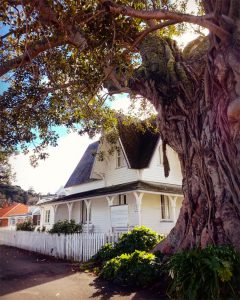 Then, we took the ferry to Paihia, a small seaside town quite touristy.
Then, we took the ferry to Paihia, a small seaside town quite touristy.
If you want to take the pedestrian ferry between Russel and Pahia, you can count on 12$* return per person. We chose to take the one way crossing with the baby elephant van from Opua for 12.5$ including everyone.
No big interests, apart from its small craft market on Sunday morning, and a charming covered alley with some restaurants and stalls. You can do a lot of activities here, it is one of the most famous places to swim with wild dolphins.
Finally, there is no point in going to Waitangi except to visit the museum housing the New-Zealand founding treaty dating from 1840. The history of the first contacts between European and Maoris around informative videos, show and visit of gardens.
Kerikeri
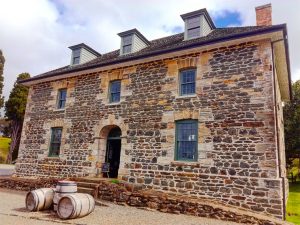 We continue our journey towards two of the oldest buildings in the country. The “Stone store” is an imposing 3 storey building of stone and wood dating from 1836. On the ground floor it is possible to visit the shop free of charge, for the upper floors you have to pay an admission to the museum (8$*). This beautiful building is surrounded by pleasant vegetable and botanical gardens and a small cafe just as unusual.
We continue our journey towards two of the oldest buildings in the country. The “Stone store” is an imposing 3 storey building of stone and wood dating from 1836. On the ground floor it is possible to visit the shop free of charge, for the upper floors you have to pay an admission to the museum (8$*). This beautiful building is surrounded by pleasant vegetable and botanical gardens and a small cafe just as unusual.
Right next to it, it is possible to take the departure of several walks more or less long, and even to walk along the river to go further and discover the Rainbow falls.
Matauri bay & St Pauls rock
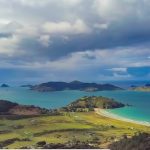 On the way to Mangonui, we took the time of two small stops.
On the way to Mangonui, we took the time of two small stops.
First the majestic Bay of Matauri, the road that leads to it delivers a view of a turquoise lagoon absolutely beautiful and still preserved, at least for now. At the end of the bay, we arrive at a campsite and behind it, a small path takes us to the top of a hill where proudly stands the Rainbow Warrior Memorial. The only attack that New Zealand has ever encountered so far, meticulously orchestrated by the French government at the time. (youpi -_-)
Our second stop was the St. Paul rock climb to enjoy, again, a breathtaking 360 ° view on an idyllic setting between land and sea, turquoise water, small harbor and greenery islands. Splendide you are told !
Mangonui
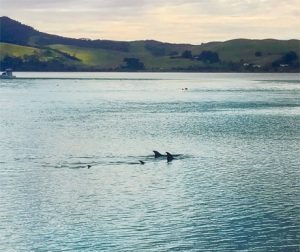 .is a very small village offering a walk in the past, let yourself be embarked by the history, through the information panels along the path, of its bay evolution, from the former Maori chiefs until the present days. A peaceful and rewarding walk that is not worth the detour.
.is a very small village offering a walk in the past, let yourself be embarked by the history, through the information panels along the path, of its bay evolution, from the former Maori chiefs until the present days. A peaceful and rewarding walk that is not worth the detour.
The spectacle that we liked the most is still the appearance of wild dolphins came to have their breakfast in the bay, to the rhythm of the fishing boats came to deliver their cargoes.
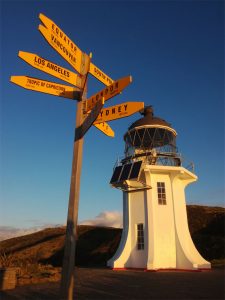 Cap Reinga
Cap Reinga
Direction the north end and the famous lighthouse of Cape Reinga. Northland’s northernmost point, and the one that marks the separation between the Tasman Sea and the Pacific Ocean. Certain days, it is also possible to see clearly the demarcation, we will unfortunately not have this chance. The trail is dotted with informative tablets of Maori legends and the lighthouse history. It is also possible to take several hiking trails that range from a few hours to several days.
Sand dunes & 90 miles beach
Let us talk about the two major activities of the region. On the Cape Reinga Peninsula, along the only road leading to the north end, you will necessarily fall on the giant sand dunes. It is also possible to find it a little further along the west coast. However, it is on the ones of Te Paki that we have chosen Sandboarding !
That is, after hiring a board for 10$ * per person for the day, you are ready for the dunes ascension and for the sensations. Sitting on the board or standing up, you can ride on the dunes as you prefer. After finding a good location, alone in what sometimes seems to be an endless desert, we had fun as kids. We loved it !!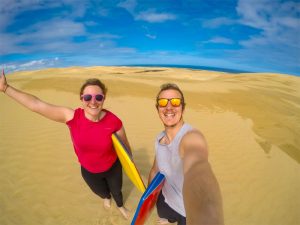
We rented our sandboards at the Red House, No. 8970, on the right just before the petrol station. This is where the boards are the cheapest. Good quality, good welcome, we recommended it.
Second activity, known as the must, of the area, the 90 miles beach. A very long sandy beach that is only interesting because it is possible to borrow it by vehicle. At low tide, just drive on it, a lot come to have fun by drifting on it, gain speed or make donuts in the sand.Seconde activité, dite incontournable, du secteur, la 90 miles beach.
Be careful, however, to be in a 4WD vehicle.
Some people dared to take the risk on it, and after to be bogged down, they had only their eyes left to weep and see their vehicle being engulfed by the slow rising tide. Aoutch ! Let us avoid dramas.
Kaiataia
The biggest city of the area, you can find there all the supplies necessary before coming down by the west coast. Apart from that, there is nothing very interesting, you can also go to “Ancient Kauris Kingdom” which is a shop proposing kauris wooden souvenirs and where you can discover different sculptures and a staircase of this same wood.
Koutu rocks & Omapere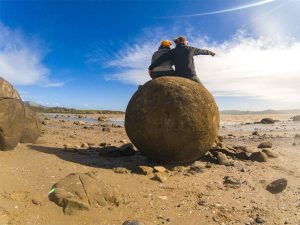
After consulting the tides schedules, small escapade in Opononi to take advantage of the Koutu boulders path. Indeed, after parking at the designated area, head towards the beach at low tide to see these strange balls of rocks. Many legends exist around the “boulders“, these pebbles perfectly smooth and round, similar to giant cannonballs, it’s interrogating as much as it’s fascinating.
The Koutu boulders are much less well known than the Moeraki boulders in the South Island, so do not hesitate to come and contemplate them in serenity. The tourist activity there is weak, we were alone on the beach to see them.
Omapere is a small seaside village, delivering a breathtaking view of the giant sand dunes. It does not cost anything to make a small stop just to enjoy the view along the way.
Waipoua forest
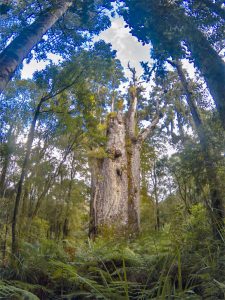 Our last stop of the region will be in the ancient Kauri forest. It was through small, well-groomed and marked walks that our shoes led us to the most imposing and old Kauris living in New Zealand.Notre dernier arrêt de la région se situera dans la forêt des anciens Kauris.
Our last stop of the region will be in the ancient Kauri forest. It was through small, well-groomed and marked walks that our shoes led us to the most imposing and old Kauris living in New Zealand.Notre dernier arrêt de la région se situera dans la forêt des anciens Kauris.
Everything is done to preserve these giants greenery tree, after rubbing and disinfecting our shoes with the equipment made available, just follow the different routes, from 20 mn to 1h30 for the longest, to go and meet these legendary trees. Thus, we found ourselves at the foot of the “Four Sisters”, four trees that developed from the same trunk, the “father of the forest” (Te Matua Ngahere), the largest kauris in New Zealand, as well as “The Lord of the Forest” (Tane Mahuta) known to be the most imposing living kauris of New Zealand and certainly the oldest.

No Comment